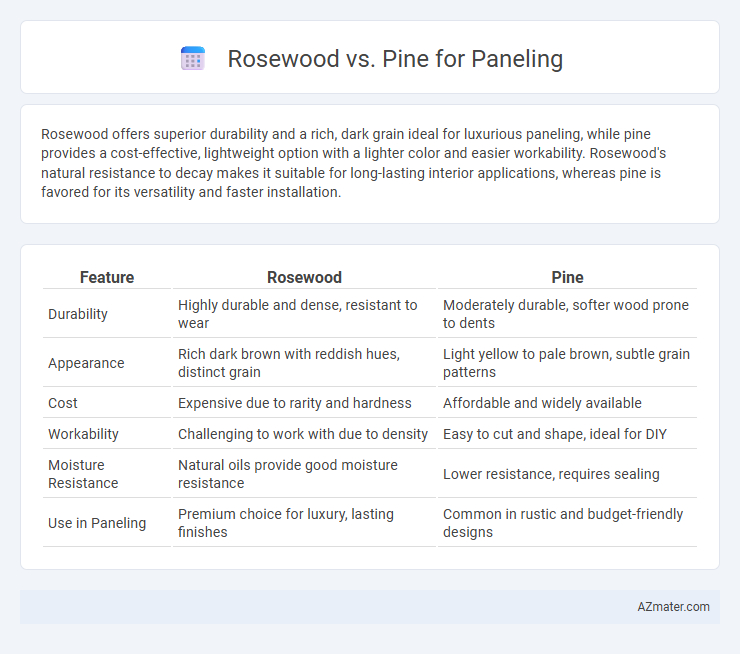Rosewood offers superior durability and a rich, dark grain ideal for luxurious paneling, while pine provides a cost-effective, lightweight option with a lighter color and easier workability. Rosewood's natural resistance to decay makes it suitable for long-lasting interior applications, whereas pine is favored for its versatility and faster installation.
Table of Comparison
| Feature | Rosewood | Pine |
|---|---|---|
| Durability | Highly durable and dense, resistant to wear | Moderately durable, softer wood prone to dents |
| Appearance | Rich dark brown with reddish hues, distinct grain | Light yellow to pale brown, subtle grain patterns |
| Cost | Expensive due to rarity and hardness | Affordable and widely available |
| Workability | Challenging to work with due to density | Easy to cut and shape, ideal for DIY |
| Moisture Resistance | Natural oils provide good moisture resistance | Lower resistance, requires sealing |
| Use in Paneling | Premium choice for luxury, lasting finishes | Common in rustic and budget-friendly designs |
Introduction to Rosewood and Pine Paneling
Rosewood paneling offers a rich, luxurious appearance with deep reddish-brown hues and natural grain patterns, making it ideal for high-end, elegant interior spaces. Pine paneling provides a more affordable and versatile option, characterized by a lighter color, prominent knots, and easy stain absorbency, suitable for rustic or casual designs. Both wood types enhance interiors differently, with rosewood emphasizing sophistication and pine offering warmth and simplicity.
Appearance and Aesthetic Differences
Rosewood offers a rich, dark brown color with striking grain patterns and natural luster, creating an elegant and luxurious look for paneling. Pine features a lighter, creamy yellow tone with subtle knots and a softer grain, contributing to a warm, rustic, and casual aesthetic. The bold contrast in hue and texture between rosewood's deep, polished finish and pine's light, natural appearance significantly influences the overall visual impact and ambiance of interior spaces.
Durability and Hardness Comparison
Rosewood offers superior durability and hardness compared to pine, making it ideal for high-traffic or impact-prone paneling areas. Its Janka hardness rating ranges from 2,200 to 2,800, significantly higher than pine's 350 to 900, indicating greater resistance to dents and scratches. Pine, being softer and less dense, is more prone to wear but easier to work with and more cost-effective for decorative paneling.
Cost and Affordability
Rosewood paneling commands a premium price due to its rarity and luxurious appearance, often costing several times more than pine. Pine offers an affordable alternative, widely available and cost-effective for large projects or budget-conscious homeowners. When deciding between the two, consider that pine's lower cost and ease of customization make it ideal for budget-friendly paneling, while rosewood's high cost reflects its durability and aesthetic appeal in upscale designs.
Maintenance and Longevity
Rosewood paneling offers exceptional durability and resistance to wear, requiring minimal maintenance due to its natural oils that repel moisture and insects. Pine paneling, though more affordable, is softer and prone to dents and scratches, demanding regular sealing or staining to maintain its appearance and protect against moisture damage. Over time, rosewood's superior longevity and less frequent upkeep make it a preferred choice for high-traffic or moisture-prone areas.
Environmental Impact and Sustainability
Rosewood paneling, sourced from slow-growing tropical hardwoods, often raises sustainability concerns due to deforestation and habitat loss, despite its durability and rich appearance. Pine, a fast-growing softwood commonly obtained from managed forests, offers a more eco-friendly alternative with lower carbon footprint and easier regeneration rates. Choosing pine supports sustainable forestry practices and reduces environmental impact compared to the more resource-intensive harvesting of rosewood.
Ease of Installation
Rosewood is denser and heavier than pine, making it more challenging to cut and install for paneling projects. Pine's softer texture and lighter weight allow for easier handling, quicker cutting, and faster fastening, which significantly reduces installation time. Choosing pine for paneling provides a user-friendly experience, especially for DIY enthusiasts and professionals seeking efficient installation.
Suitability for Different Settings
Rosewood offers rich color and natural durability, making it ideal for high-end interior paneling in luxury homes, offices, and formal spaces. Pine provides an affordable, lightweight option with a warm, rustic aesthetic suitable for casual settings, cottages, and farmhouse-style interiors. The choice between Rosewood and Pine depends on the desired aesthetic, budget, and environmental conditions of the installation area.
Sound Insulation and Acoustic Qualities
Rosewood offers superior sound insulation and acoustic qualities compared to pine, due to its dense and hard grain structure that effectively absorbs and dampens sound waves. Pine, being softer and more porous, allows more sound transmission, making it less ideal for soundproofing applications in paneling. Selecting rosewood for paneling enhances room acoustics by reducing echo and noise, providing a quieter and more acoustically balanced environment.
Choosing the Right Wood for Your Paneling Project
Rosewood offers exceptional durability and rich, deep hues that bring a luxurious and elegant look to paneling, making it ideal for high-end interiors where aesthetics and longevity are priorities. Pine, being a softwood, provides a more affordable and versatile option with a lighter color palette, perfect for rustic or casual designs and easier customization through staining or painting. Selecting the right wood depends on the desired finish, budget, and the environmental conditions of the space, with rosewood excelling in premium applications and pine suited for cost-effective, adaptable projects.

Infographic: Rosewood vs Pine for Paneling
 azmater.com
azmater.com